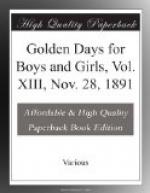DISTRICT COLUMBIA.—No vessel has ever been built that exceeded the Great Eastern in size. Her dimensions were: Length, 680 feet, between perpendiculars, or 692 feet upper deck; breadth, 83 feet, or 118 feet over paddle-boxes: height of hull, 60 feet, or 70 feet to the top of the bulwarks. The paddle-wheels were 56 feet in diameter by 13 feet in depth, with 30 spokes in each wheel, and the coal-bunkers, to supply all the engines, could contain 14,000 tons. Her propeller-shaft was 160 feet long, with a screw propeller at one end 24 feet in diameter. She had 6 masts, carrying 7000 yards of sail, as auxiliary to the steam power: 10 cables, some of which weighed 10 tons each. She had facilities for accommodating 800 saloon passengers, 2000 second class, 1200 third class and 400 officers and crew; or 5000 might have been placed on her, if emigrants or troops. She was used for several purposes, serving as a troop ship in 1861, as a passenger vessel, and then was permanently chartered for laying the Atlantic cable, all of the passenger fittings being removed in 1867. In this she proved a success, having been used, not only for the laying of the cable named, but also for several other important lines, in the Mediterranean, in the Red Sea, across the Indian Ocean and elsewhere. Then she was laid up, and the last report concerning her was that, after being run for a short time as a coal ship, she was sold and broken up, having outlived her usefulness. The enormous expense attendant upon the maintenance of such an ocean monster proved a drawback to continued success from the day she was launched, at Millwall, England, January 31, 1858.
HARRY and JAY. Two exchange notices from one person are allowed in each volume, thus giving all our readers an equal chance.—HENRY M.S. Your query was answered in No. 51, Vol. 12, in its regular turn.—F.H.G. Addresses of any description are never given in this department. —BILLY. Commodore George Dewey is Chief of the Bureau of Equipment and Recruiting, Navy Department. Washington, D.C.—INQUIS I. TIVE “Electro-Motors and How to Make Them,” No. 3. Vol. 12.—W.R. No premium.—STUDENT. The book may be procured from a local dealer.—H.G.B. It is supposed to be a reliable institution.—CHAS. McG 1. The course pointed out is the only one to pursue. If you allow a false modesty to deter you, nothing remains to be done but suffer. 2. The exchange notice is too trivial.—WEEKLY BUYER. Stove trimmings are nickel-plated in the regular way. Read the article on electro-plating in Vol. 11, No. 23.—EDWARD B. Selling cheap jewelry and novelties on the street corners may net a living income in large cities to those who are experienced in such work, usually called “faking.” It is not at all probable that it could be made a profitable calling in Texas.—X.Y.Z. Perpetual motion stands at the head of the absolute impossibilities of life; therefore, the government has never offered a prize for the solution of this mythical problem.—RANGER. Nitro-glycerine is one of the most dangerous explosives known; consequently, we cannot conscientiously describe its manufacture in this place, thus jeopardizing the lives of thoughtless persons who might attempt to make it if such a formula was furnished. —E.C.S. If in first-class condition, the three-dollar gold-piece of 1878 might be sold for $3.40.




